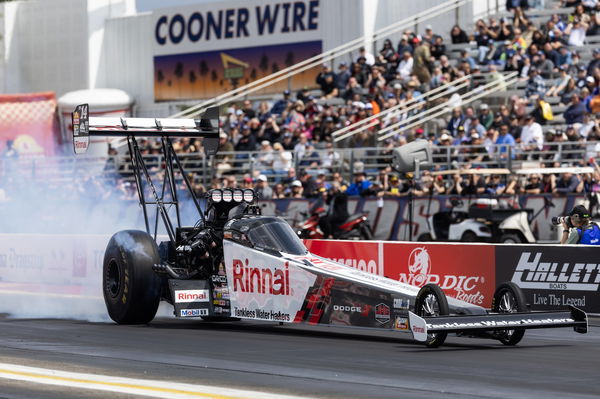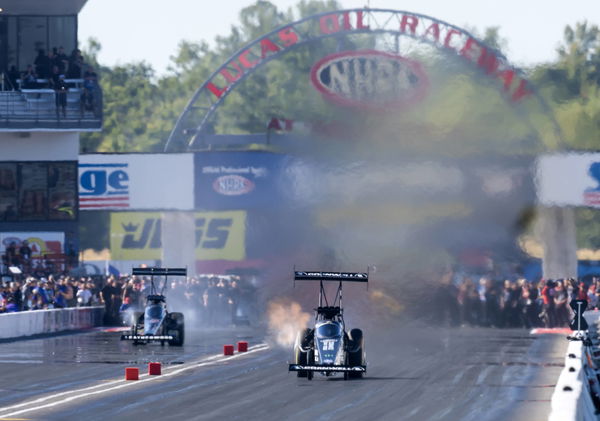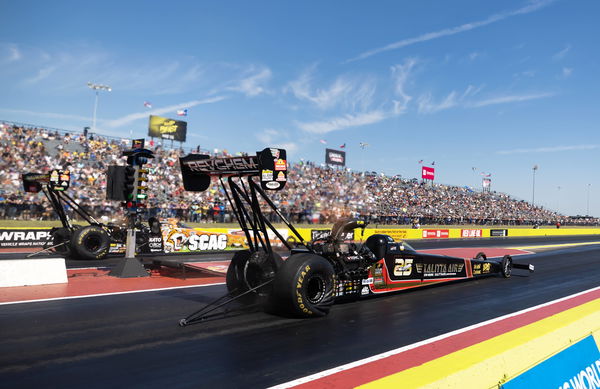
Imago
Motorsport, Herren, USA, Dragster Drag Race Winternationals Mar 28, 2025 Pomona, CA, USA NHRA top fuel driver Doug Kalitta celebrates after winning the All Star Callout specialty race during qualifying for the Winternationals at In-N-Out Burger Dragstrip at Pomona. Pomona In-N-Out Burger Dragstrip at Pomona CA USA, EDITORIAL USE ONLY PUBLICATIONxINxGERxSUIxAUTxONLY Copyright: xMarkxJ.xRebilasx 20250328_mjr_su5_006

Imago
Motorsport, Herren, USA, Dragster Drag Race Winternationals Mar 28, 2025 Pomona, CA, USA NHRA top fuel driver Doug Kalitta celebrates after winning the All Star Callout specialty race during qualifying for the Winternationals at In-N-Out Burger Dragstrip at Pomona. Pomona In-N-Out Burger Dragstrip at Pomona CA USA, EDITORIAL USE ONLY PUBLICATIONxINxGERxSUIxAUTxONLY Copyright: xMarkxJ.xRebilasx 20250328_mjr_su5_006
As the National Hot Rod Association (NHRA) prepares for its season-ending race this coming weekend – the NHRA In-N-Out Burger Finals at In-N-Out Pomona Dragway in Pomona, California, about 50 miles east of Los Angeles – teams are already looking ahead to the 2026 season, when the NHRA will celebrate its milestone 75 anniversary as the premier sanctioning body in drag racing.
Watch What’s Trending Now!
NHRA has a massive advantage over its closest competitor, the International Hot Rod Association, in terms of fans, races, TV coverage, and especially drag strips.
The NHRA hosts a 20-race season, with events held at 17 different tracks (Charlotte’s zMAX Dragway, Pomona and Las Vegas all host two races in the same season).
ADVERTISEMENT
Let’s take a look at the top five drag strips on the NHRA circuit and what makes them so special:
In-N-Out Burger Pomona Dragstrip:
It was really hard to not make this a tie with Indianapolis Raceway Park. But because the legendary In-N-Out Burger Pomona Dragstrip track hosts two national events per year – the Winternationals and the season-ending Finals – it gets a slight edge over Indy. Plus, the sport of drag racing and NHRA were both born in Pomona’s backyard, namely, Southern California, back in the early 1950s.
Located at the Fairplex, Pomona has pretty much everything a drag racing fan needs: great aesthetics, great weather in both late March and mid-November, and particularly great competition. For whatever reason, and much like when the drag racing world convenes every Labor Day Weekend at Indianapolis, it seems that every team and driver picks up their game whenever they race at Pomona, regardless of whether it’s early in the year or in the late fall.

Imago
Motorsport, Herren, USA, Dragster Drag Race Winternationals Mar 29, 2025 Pomona, CA, USA NHRA top fuel driver Tony Stewart during qualifying for the Winternationals at In-N-Out Burger Dragstrip at Pomona. Pomona In-N-Out Burger Dragstrip at Pomona CA USA, EDITORIAL USE ONLY PUBLICATIONxINxGERxSUIxAUTxONLY Copyright: xMarkxJ.xRebilasx 20250329_mjr_su5_007
What’s more, Pomona has great freeway access for fans to reach the track, countless fast food joints and restaurants within a five-mile radius (my favorite is the Pomona Valley Mining Company, about two miles from the track), and a history and legacy that fans and drivers know all too well as the place where greats like “Big Daddy” Don Garlits, Don “Snake” Prudhomme, Kenny Bernstein, John Force and so many others performed some of their greatest feats in the sport.
Facility-wise, Pomona – which is actually owned by the County of Los Angeles – is somewhat of a mix between old and new. Sure, some of the facilities could stand a bit of massaging and updating, but if you want to see nothing but great racing and raw competition, this is the best place to be. And fans and the sport get to do just that twice each season.
Indianapolis Raceway Park:
Known as the home for the legendary U.S. Nationals (nicknamed “The Big Go”), IRP – its actual name is Lucas Oil Indianapolis Raceway Park – hosts the longest-running event on the NHRA calendar. It is a massive racing complex that contains not only a state-of-the-art drag strip and new facilities that have been built in the last couple of years, it also has a short track for fans who prefer NASCAR-style racing, as well, plus a 2.5-mile road course.
While the Indianapolis area does get significant snow and cold weather in the winter, its central location in the U.S. still managed to convince many of drag racing’s top teams – particularly those in the Top Fuel and Funny Car ranks – to either relocate there (mostly from sunny and warmer Southern California) or to have a significant satellite presence that makes it much easier for teams – and especially their long-distance hauler drivers – to shorten what oftentimes can be multiple trips of over 2,000 miles cross-country between races.

Imago
Motorsport, Herren, USA, Dragster Drag Race US Nationals Sep 1, 2025 Clermont, IN, USA NHRA top fuel driver Brittany Force runs the fastest speed in NHRA history at 343.51 mph during the US Nationals at Lucas Oil Indianapolis Raceway Park. Clermont Lucas Oil Indianapolis Raceway Park IN USA, EDITORIAL USE ONLY PUBLICATIONxINxGERxSUIxAUTxONLY Copyright: xMarkxJ.xRebilasx 20250901_mjr_su5_021
Admittedly, new racing fans sometimes get IRP confused with its more well-known big brother, Indianapolis Motor Speedway, home of the world’s biggest race, the Indianapolis 500, which is just over six miles to the east.
The U.S. Nationals are the biggest and baddest show in drag racing, an event that stretches over five days over the Labor Day Weekend and brings out anyone who is anyone in the sport. Even if a team competes in only a few races per season, racing at Indy is a must-do event that typically brings out close to 1,000 cars every year, both in the pro ranks as well as numerous sportsman/amateur classes.
Even if a team has a terrible season in general, if it does well in the U.S. Nationals at IRP – and even more so if it wins or finishes runner-up – it most definitely becomes the high point of their season and helps them call it a successful season.
Gainesville Raceway:
The north-central Florida track has almost the same kind of reputation as Pomona and IRP. If you’re a race fan, going to Gainesville is an almost must-see item that should be on every drag racing fan’s bucket list. This is where Kenny Bernstein became the first driver to break the 300 mph barrier in Top Fuel, on March 20, 1992, an iconic moment in NHRA history.
Race teams enjoy coming to Gainesville because it’s the season-opener for most classes, but particularly for Top Fuel and Funny Car. It gives teams a chance to see what they have under the hood, so to speak, as well as what improvements they’ve been able to implement during the off-season. It also gives teams a benchmark to build off of and go forward from after seeing how their cars performed in the season opener.

Imago
Motorsport, Herren, USA, Dragster Drag Race Gatornationals Mar 9, 2025 Gainesville, FL, USA General view of NHRA fans in the grandstands during the Gatornationals at Gainesville Raceway. Gainesville Gainesville Raceway FL USA, EDITORIAL USE ONLY PUBLICATIONxINxGERxSUIxAUTxONLY Copyright: xMarkxJ.xRebilasx 20250309_mjr_su5_015
Gainesville also has something that no other NHRA track can boast: it has a real, live alligator that calls the pond adjacent to the track its home. Fans have been known to taunt the gator – obviously, why the race is called the Gatornationals – and they’re lucky there’s a heavy-duty fence that keeps the alligator from attacking them.
NHRA drag racer Alex Laughlin had one of the most memorable moments in the sport’s and track’s history back in 2022. When racing was called off for the day due to rain (a typical impediment in the early spring in the area), Laughlin decided to test out his radio-controlled toy boat in the pond. We’re not sure if Laughlin intentionally tried to draw the alligator’s ire or what, but let’s just say his RC-boat didn’t last very long and became the gator’s lunch (the boat, not Laughlin).
Another nice thing about attending the Gatornationals is that it’s only a two-hour drive from Walt Disney World less than 100 miles from Daytona Beach, Florida, home of NASCAR’s Daytona 500 (not to mention great beaches up and down the east coast of the state). What better way to spend a late winter/early spring vacation than drag racing and sightseeing?
The Strip at Las Vegas Motor Speedway:
One of only two tracks that has four drag racing lanes (the other is its sister facility, zMAX Dragway in suburban Charlotte, North Carolina, both owned by Speedway Motorsports Inc.), The Strip has great aesthetics, a top-notch racing surface (although there have been times when dust and sand blow across the track, temporarily stopping the racing until the track is cleaned up), and is definitely a fan favorite because of all the fun and games not just at-track, but all the gambling and entertainment that Sin City has to offer.
However, drag racing fans will likely not experience four-wide racing at Las Vegas in the 2026 season as NHRA will only have one four-lane event on the schedule, at zMAX Dragway. There’s a possibility the four-wide event will return to Las Vegas in 2027, but that remains to be seen.
The concrete and asphalt racing surface is among the best in the sport. Apart from racing, the backdrop of the Las Vegas skyline and the night races under desert lights create an atmosphere that’s unmatched anywhere else on the NHRA calendar.

Imago
LAS VEGAS, NV – NOVEMBER 02: Brittany Force 5 TF Motorsport, Herren, USA, Dragster Drag Race Top Fuel Dragster celebrates after winning the Dodge NHRA Nevada Nationals powered by Direct Connection on November 2, 2025 at The Strip at Las Vegas Motor Speedway in Las Vegas, Nevada.Photo by Matthew Bolt/Icon Sportswire AUTO: NOV 02 Dodge NHRA Nevada Nationals EDITORIAL USE ONLY Icon290900308369
Las Vegas has one other thing that other facilities oftentimes can be in short supply of: a wide variety of hotel room prices, from budget-friendly to top luxury places to rest your head at night, making it one of the most cost-friendly locales on the NHRA circuit. Las Vegas reportedly has over 150,000 hotel rooms across more than 350 hotels and motels, according to Reference.com.
To be fair, The Strip’s sister track, zMAX Dragway in Charlotte, is a near-identical match to its Nevada counterpart. What is said about The Strip pretty much is equal to what is said about zMAX (with the exception of the dust and sand), thus eliminating the need to give zMAX its own separate listing on this list.
Texas Motorplex:
An NHRA staple since it opened in 1986, the Motorplex was the first all-concrete quarter-mile drag racing facility in the U.S.
To the credit of track founder and builder Billy Meyer, even though it turns 40 years old next year, the Motorplex – nicknamed simply “The Plex” by many – continues to keep up with time and progress, making considerable renovations to the facility both on- and off-track.

Imago
Motorsport, Herren, USA, Dragster Drag Race Fall Nationals Oct 11, 2025 Ennis, TX, USA NHRA top fuel driver Shawn Langdon near races alongside Justin Ashley during qualifying for the Fall Nationals at the Texas Motorplex. Ennis Texas Motorplex TX USA, EDITORIAL USE ONLY PUBLICATIONxINxGERxSUIxAUTxONLY Copyright: xMarkxJ.xRebilasx 20251011_mjr_su5_007
Situated 37 miles south of Dallas and 57 miles southeast of Fort Worth, the Motorplex is among the most favorite tracks for drag racers, their teams and their fans in the South and Southwest. The annual Fall Nationals is perennially sold out and provides some of the most memorable passes the sport has seen in its four-decade existence.
The old saying about things being bigger and better in Texas definitely includes drag racing at the Motorplex.
Honorable mention:
No list of this nature would be complete without mentioning Route 66 Raceway in Joliet, Illinois, about an hour southwest of downtown Chicago. Opened in 1998, it billed itself as the “first stadium of drag racing” because of how the seating wraps around the track like a horseshoe.
However, the title of the first true “stadium of drag racing” goes to Bristol Dragway (across the street from the NASCAR-renowned Bristol Motor Speedway), built in the early 1960s, in and of itself also a track that could be included in an honorable mention category.
Route 66 held NHRA races – including some seasons where it hosted two events in the same year – but sat idle from 2019 until 2023, when NHRA returned. The facility, which also includes a .375-mile dirt oval, is adjacent to Chicagoland Speedway, which will reopen after a seven-year hiatus for NASCAR’s July 4 weekend event (which will replace, at least for the time being, the Chicago Street Race in downtown Chicago). NASCAR owns both Route 66 and Chicagoland Speedway.
ADVERTISEMENT
ADVERTISEMENT
ADVERTISEMENT

